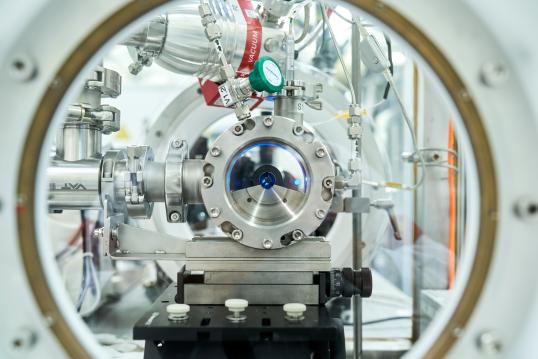The Fuels and Materials Research Laboratory provides the scientific basis for the objective assessment and modelling of the safety-related behaviour of nuclear materials, with emphasis on nuclear fuels, under normal and off-normal operating conditions. In this framework, it serves European and international authorities as well as academic and research organisations.
The main activities covered by the FMR laboratory involve the synthesis and characterisation of actinide-containing materials (including plutonium and minor actinides), their characterisation and the study of their thermodynamic and thermophysical properties from very low (liquid He) to very high (>4000 K) temperatures.
Research activities
Research activities carried out in the FMR laboratory encompass the following fields: the synthesis and characterisation of actinide-containing materials relevant for the assessment of nuclear safety standards (oxides, carbides, nitrides…) the safety characterisation of new forms of nuclear fuels in particular molten salts, the laboratory simulation of nuclear power plant severe accident conditions, the implementation and use of advanced methods for the synthesis of nuclear material assemblies for Generation IV nuclear power plants, including transmutation targets, or for space or medical applications; exploratory investigations for the development of new scientific concepts, testing of new equipment or materials.
Standard and advanced techniques for sample synthesis, materials characterization and safety experiments are employed. These include sol-gel precipitation, powder blending and pressing, conventional or spark plasma sintering, encapsulation techniques, X-ray diffraction, vibrational spectroscopy (Raman and infra-red), electron microscopy (scanning and transmission) and focused ion beam, drop and differential scanning calorimetry, Knudsen cell effusion mass spectrometry, electro-motive force analysis, dilatometry, indentation, laser flash methods for the measurement of thermal properties, laser melting, etc.
Safety precautions at Universities in Europe have almost excluded the possibility of working beyond uranium in the periodic table, with JRC’s unique facilities being opened to the academic community on the basis of peer-reviewed proposals, Europe’s researchers can still be at the cutting edge of investigations on actinide-containing materials.
The FMR laboratory is equipped with state-of-the-art instruments designed for applied and fundamental research on the synthesis, behaviour and properties of actinide materials both under normal and extreme conditions of temperature and chemical environment. These facilities can be used also to investigate other types of compounds under conditions that cannot be produced elsewhere, like for example ultra-refractory ceramics at temperatures exceeding 3000 K.
| Activity | Facility (GB= sample in Glove Box) (SC= sample in Safe Container) | Remarks |
|---|---|---|
| Sample Preparation | Sol-gel (GB, SC) Powder metallurgy (GB, SC) Furnace sintering (GB, SC) Spark Plasma Sintering (SC, GB) Laser melting synthesis (GB, SC) | For the preparation of polycrystalline materials |
| Sample Characterization | Powder X-ray diffraction (GB)* Transmission Electron Microscopy (GB)* Scanning Electron Microscopy (SC, GB) Electron Micro-Probe (GB)* Focussed Ion Beam (SC) Raman Spectroscopy (GB, SC) Infra-Red spectroscopy (GB) Thermo-Gravimetry (GB, SC) | *Also for small quantities of irradiated fuel |
| Thermodynamic Properties | Knudsen Cell Mass Spectometry (GB) Differential scanning calorimetry (SC, GB) Drop Calorimetry (GB, SC) Laser Heating thermal analysis | For the study of vapour pressures, helium and fission gas release from 400 K to 2800 K Between 300 K and 1500 K Between 500 K and 1800 K For the study of high temperature phase transitions (T>2000 K), including melting |
| Thermophysical properties | Laser Flash (Lead shielded GB) CLASH equipment (SC) Radiance spectroscopy of laser-heated samples | For the study of thermal diffusivity and conductivity between 600 K and 1800 K, also in irradiated fuel. For the study of thermal diffusivity between 1200 K and 3000 K. For the study of spectral emissivity in the visible near-infrared range at T>1500 K. |
| Sample Encapsulation | Laser and TIG welding of metallic capsules |
Previous open access calls
Previous open access calls can be visited here.
Laboratory photos
A disk-shaped sample mounted inside a vacuum chamber. © European Union, 2021
You can view additional images of the Fuels and Material Research laboratory at the JRC Digital Media Hub.


